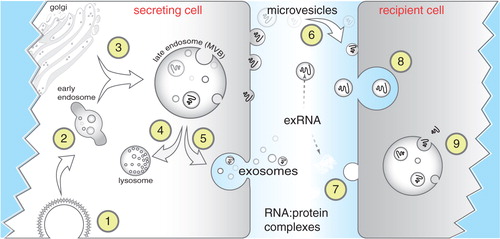Figures & data
Fig. 1. Biogenesis and uptake of exRNA. Endocytosis is commonly mediated via clathrin-coated pits (Citation1) after which endocytic vesicles progress from early (Citation2) to late endosomes, also referred to as multivesicular bodies (MVBs). MVBs often fuse with lysosomes for degradation (Citation4) but can also fuse with the plasma membrane (Citation5) thereby releasing exosomes (40–100 nm) to the extracellular space. Microvesicles are larger fragments of plasma membrane that are shed from almost all cells (Citation6). Extracellular RNA (exRNA) can be detected in exosomes and microvesicles, associated with proteins (Citation7), or as part of lipoprotein particles, particularly HDL. exRNA released from secreting cells can be taken up by recipient cells through receptor-mediated endocytosis (Citation8), by fusion of membranes, or by uptake of RNA–protein complexes or lipoproteins. Although the exact mechanisms remain unclear, exRNA is released inside recipient cells (Citation9) to effect changes in gene expression.

